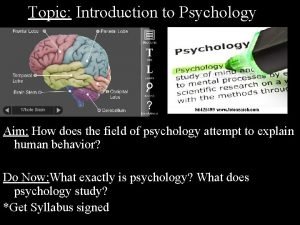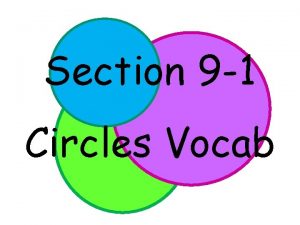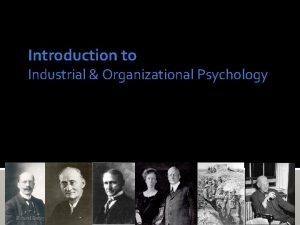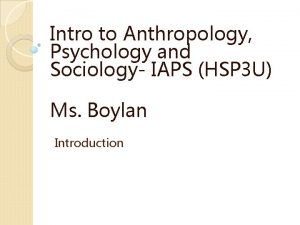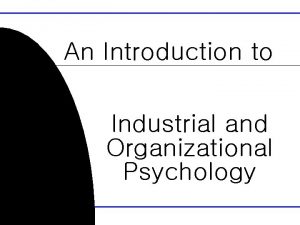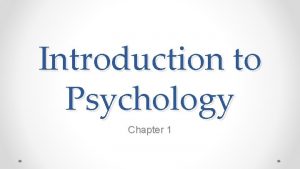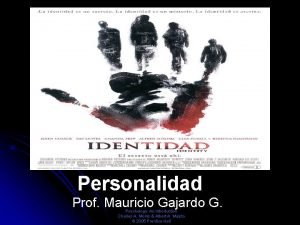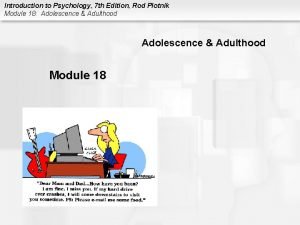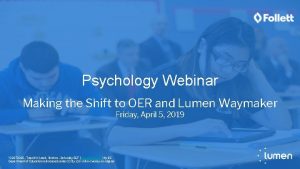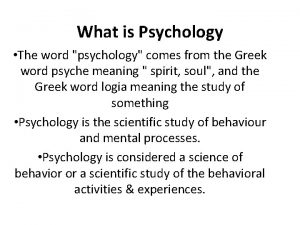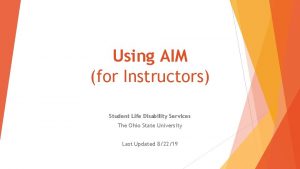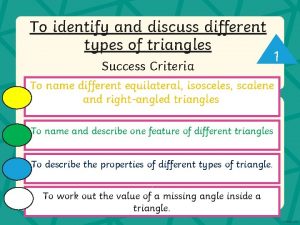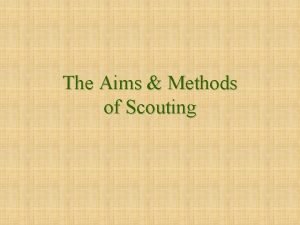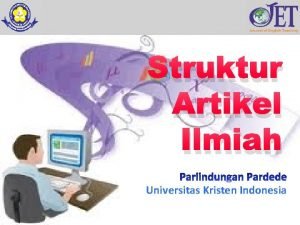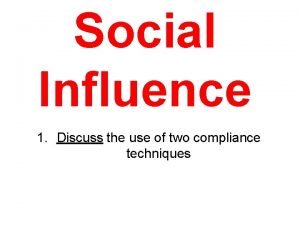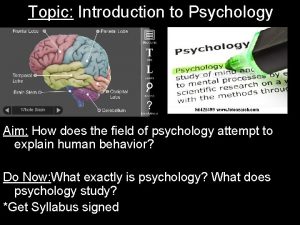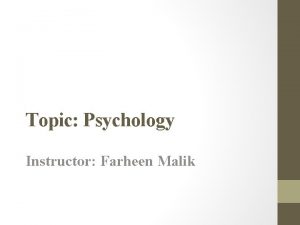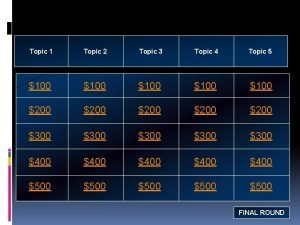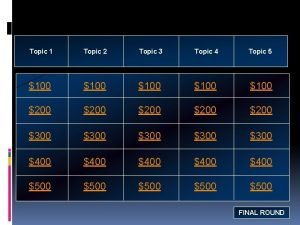Topic Introduction to Psychology Aim How does the


























































































- Slides: 90

Topic: Introduction to Psychology Aim: How does the field of psychology attempt to explain human behavior? Do Now: What exactly is psychology? What does psychology study? *Get Syllabus signed

*The next few slides are a modification (shortened) version of the main points on the course syllabus, located on the class website. Contact Information: Email: nelsonsaphumangeography@gmail. com Social Studies department phone (516 -488 -9631) Course Website: www. nelsonspsychology. weebly. com *All materials, videos, class Power. Points, handouts, and assignments (including this syllabus) are on the website. Should you need to view materials over again, or need extra copies (if you lose or are absent), please download off of the website – do not ask me for more copies!

Talking Points About This Class: • You chose this class – take it seriously – if you’re here to hang out please drop class – you don’t have to be in here. • Maturity of topics in Psychology • Purpose of films and video clips – not a waste of time. • Active participation and engagement in class – this is not a lecture course! • One of the most common college electives/majors – want people to get good idea of what Psychology is before college/applied psych

Grading Your semester grade is a 50/50 combination of class participation (speaking in class during discussions) and the assignments in your Assignment packet. The COURSE grade overall is combination is comprised of the following 3 grades: • WRITTEN ASSIGNMENTS: (50%) Projects, media assignments (films/documentaries), article write-ups, research projects, and/or social experiments will be given regularly. *ALL PROJECTS MUST BE EMAILED. LATE WORK DOESN’T EXIST! • Class Participation: (50%) As previously stated, class participation will weigh heavily on your grade. Participation does not necessarily mean that you have your hand up every 5 minutes in class, but rather that you take an active role in class during discussions, questions asked by myself, and in any group work. • FINAL RESEARCH PROJECT & PRESENTATION: (20% of your overall course grade AND 20% of your 2 nd marking period average) this course has a mandatory in-class presentation as a final exam.

Grading Equation: **Grades for this course are calculated on a point system, meaning you will accumulate a certain amount of points throughout the course. Your accumulated points, divided by the total amount of points offered, equals your grade. For example: • Teacher gave: 500 total points (tests, quizzes, projects, etc) • Student received: 400 of those points • 400/500 • Student Grade= 80%

Participation Grading Rubric (how I evaluate this grade): Participation is graded as a 1 time test grade (per marking period), evaluated out of 100 points. This is equivalent to 2 full project grades – appropriate when we have over 80 classes in which there are daily opportunities to participate. So you can better understand where the grade I gave you came from, please see the following rubric (this is on the website as well, top of page). *In all cases the range (e. g. , 60 -70%) is subject to my personal evaluation of BOTH the quality and the frequency of your comments, taken in tandem. To receive the highest grades, both variables should be high. 90 -100% Daily, High Quality Contributions: participation that is thoughtful, insightful, reflects a strong understanding of sociological concepts, is relevant to what we’re discussing, makes a clear contribution to class, and occurs daily (if not several times per class). 80 -90% Consistent (but not daily) High Contributions: This accounts for participation that occurs several times a week, shows a good understanding of course content and sociological concepts, and makes a good (not great) overall contribution to the class. 70 -80% Occasional, Non-Consistent Contributions: these are comments that are occasional in nature, of varying quality, and make some connection to course content, 60 -70% Rare Contributions: these are for the students who speak very sporadically, making little tangible contribution to class discussions. This could be localized to only participating on a single topic that interests you, rather than all (or most) topics. 50% Non-Class Contributor: you have either only participated a handful of times, or never participated whatsoever in class.

Procedure for any missed emails (*to avoid the “What do you mean I got a zero! I emailed it to you, I swear!” moments…) I say that you are missing work, and you say that you emailed me, on time, this is what you do…) You must take screen shots of BOTH of the following (see example below): 1. The “SENT” email from your “SENT” folder, which shows your address, my address, time stamp, and that there was an attached file. No one erases sent emails, so if you sent it, it will still be there. Below is an image of this handout emailed to myself 2. The opened Assignment itself with you: name & date clearly visible, to the following email (check you spelling, please):

What is Psychology? • The scientific study of behavior (actions) and mental processes (internal thoughts and brain patterns). Uses the scientific method • Includes the study of both humans and animals

So how can Psychology be used in our lives?

Psychology can help you learn about yourself: • Why am I shy or outgoing? • Why do I like or dislike certain types of foods? • Why am I attracted to certain types of people and not others? • Why do I always worry? Or, why am I so calm all the time? • Why are my moods so different from day to day? • Why do I choose the types of friends that I do • Why am I afraid of certain things that other people are not?

Psychology can help guide your future jobs/careers (not just in Psychology) Criminal Justice: What motivates people to commit crimes? Why would someone confess to a horrible crime that they didn’t commit (Central Park 5, West Memphis 3, etc). Why, after hearing a false confession, is it nearly impossible for people to change their opinion of perpetrators guilt, even in the face of physical evidence? Politics Why does image matter so much to voters? What motivates people to vote or not vote? Journalism To what extent do people believe everything they read? How much of an influence does media have over perception, thought, and behavior? Why does choice of media say about personality and intelligence? (e. g. – reading news on Facebook vs. the Wall Street Journal)

Psychology is everywhere in our lives… • Why do you think stores put so many candies and sweet snacks on the center shelves of most isles?

Psychology helps us understand our own cognition (though processes)…for example

Survivorship Bias: • Success is made more visible to us than failure, therefore we OVERESTIMATE our chances of success is certain areas. The millions of people who fail don’t write books, they don’t appear on T. V. , and they don’t travel the country giving lectures on how they didn’t accomplish their goals! How do you think this works with celebrity success stories? Think of Mark Zuckerberg and FB, or a successful hip-hop artist, or a famous athlete?

Survivorship Bias in the media…

Social Proof (aka ‘herd instinct’): • People feel something is the correct thing to do/say when they are doing the same as others. Why? Evolutionary psychologists believe it was a survival strategy from Neolithic days. How do you think advertising and businesses take advantage of this?


The Clustering Illusion: • The human brain craves patterns to make sense of the world – we are oversensitive to patterns that don’t exist. We see shapes in the clouds, patterns in your scantron test answers, patterns in lottery winnings/slot machines!

Sunk Cost Fallacy: • When we hold onto bad things because we feel like we’ve invested so much into them. • How do you think this works with relationships? • Businesses? • Even something like reading a book or watching a movie?

Reciprocity (first give, then take): • Psychologist Robert Cialdini studied the tendency for people to be very uncomfortable being in other’s debt. • Giving presents? • Charitable organizations who want you to donate to them? • Inviting people to events you have?

Confirmation Bias: • We have beliefs about the world we live in, and we tend to only listen to information that confirms those beliefs, and disregard information the contradicts them. • How we feel about people? • How you feel about SHS? • Religious or philosophical beliefs?

• What is the difference between the fields of “Psychology” and “Psychiatry”?

Psychology vs. Psychiatry: • Psychiatry is a branch of medicine that utilizes the use of medication. Psychiatrists are MD’s (medical doctors) - psychologists are not - they have college degrees in Psychology • Psychopharmacology: the scientific study of the actions of drugs and their effects on mood, sensation, thinking, and behavior.


The Placebo Effect: • When people show a reaction to a drug or treatment that isn’t real because they believe that it is real and will help them. • Used in psychological lab experiments

So how exactly do psychologists study all those things? • How do you think psychologists go about finding answers to questions about human behavior, the human brain, human emotions, and other aspects of human activity?

Psychology starts with questions…(how would you attempt to answer these questions scientifically? ) 1. 2. 3. 4. 5. 6. Does involvement in HS athletics improve academic performance? Does excessive texting impede face-to-face relationships? Does personality influence musical preferences? Do ads portraying unrealistic body types reduce the self-image of the viewer? Does student consumption of caffeine in the morning improve first period grades? Do teacher websites improve student performance in class? Does focus on minor rules (flip-flops and hats) reduce student adherence to major rules (insubordination or class cutting)?

6 Psychological Methodologies: 1. 2. 3. 4. Observation Research Therapy Analysis of case studies (Freud’s “Rat Man”, for example) 5. Analysis of brain biochemistry 6. Experimentation

Naturalistic Observation – Observation in natural setting – Negative of this is observer bias (What do you think this means? ) – Observing and recording behavior of animals in the wild, to recording self-seating patterns in lunch rooms in a multiracial school constitutes naturalistic observation. Has anyone bothered to observe interesting behaviors in the hallways between classes or the cafeteria?

Surveys: – A technique for ascertaining the selfreported attitudes, opinions or behaviors of people usually by questioning a representative, random sample of people. EXAMPLE: Would you rate how much you care about your education as: A. ) very much B. ) Somewhat C. ) Not a lot D. ) I don’t care at all


Personality Survey Testing: Sample Self-Esteem Personality Questions: • “On the whole, I’m satisfied with myself” T/F • “I feel useless at times” T/F • “I feel that I have a number of good qualities” T/F Sample Jealousy Test (Imagine you are in a relationship with person X) • “I suspect that X may be attracted to someone else” T/F (How would you react to the following emotionally? ) • “X hugs and kisses a member of the opposite sex” • “X comments to you how attractive a member of the opposite sex is”

• If you were to create a story as to what happened in this picture, what you say?

Developed by Henry Murray, the Thematic Apperception Test (TAT) is a projective test in which people express their inner feelings and interests through the stories they make up about ambiguous scenes.


Examples of Psychological Tests:

Describe what you see in this picture?

Describe what you see in this picture?

9 dots: connect the 9 dots using 4 straight lines, never lifting your pen, and never retracing any lines “A century of research has established that in the laboratory, at most 5 percent of participants manage to crack it, and very likely fewer manage to do so. ” -Scientific American Mind, December 2012 “Think Like a Genius” issue

Solving this requires letting go of the idea that the dots form the border of an imaginary grid (which they don’t!). We tend to see the dots as forming a square with rigid boundaries.

• The Stroop Effect: Volunteer? ? ? • Read the colors, not the words!


Free Association Activity: • For each word below, write down in your notebook what you immediately think of when you see the word. Don’t think too much! 1. Parents 2. School 3. Love

Problems with Psychological Research: Think of all the psychological research methods we discussed (observation, lab experiments, etc. ) - what are some problems with this type of research?

Correlation Research: What is the difference between a correlation and causality? • Correlation: There is a relationship between 2 variables – doesn’t mean one causes the other • Causality: One variable causes the other to happen Correlated variables: homosexuality and older brothers, cavities and test scores, price of stocks and women’s skirt lengths…drowning deaths and ice cream consumption.

Examples of Correlations • Cities with a lot of murders also tend to have a lot of police officers • Some of the most talented doctors have the highest mortality (death) rate of their patients

Correlation Three Possible Cause-Effect Relationships (1) Low self-esteem could cause Depression or (2) Depression could cause Low self-esteem or (3) Distressing events or biological predisposition Low self-esteem could cause and Depression

Correlation is not Causation: It only predicts!!!! • Children with big feet reason better than children with small feet. – (Children who are older have bigger feet than younger children; thus they can reason better) • Study done in Korea: The most predictive factor in the use of birth control use was the number of appliances in the home. – (Those who have electrical appliances probably have higher socioeconomic level, and thus are probably better educated. )

Correlation is not Causation: It only predicts!!!! • People who often ate Frosted Flakes as children had half the cancer rate of those who never ate the cereal. Conversely, those who often ate oatmeal as children were four times more likely to develop cancer than those who did not. – Cancer tends to be a disease of later life. Those who ate Frosted Flakes are younger. In fact, the cereal was not around until the 1950 s (when older respondents were children, and so they are much more likely to have eaten oatmeal. )

Famous Psychological Case Studies & Experiments

The Stanford Marshmallow Experiment

“Little Albert” Fear Experiment (1920) • Attempted to prove that fear is innate (natural) – and that it could be induced using classical conditioning and stimulus generalization. • Wanted to condition fear in an otherwise emotionally stable child.

Keltner (2003) – UC Berkley • A 2003 study published in the journal Psychological Review put students into groups of three to write a short paper together. Two students were instructed to write the paper, while the other was told to evaluate the paper and determine how much each student would be paid. In the middle of their work, a researcher brought in a plate of five cookies. Although generally the last cookie was never eaten, the "boss" almost always ate the fourth cookie -- and ate it sloppily, mouth open.

The Lost Children of Rockdale County • Studied a Syphilis epidemic at a high school in an affluent suburb of Atlanta in 1996 - affected over 200 students, some as young as 12!

Phineas Gage: • Phineas P. Gage (July 9, 1823 through May 21, 1860) was an American railroad construction foreman now remembered for his improbable survival of an accident in which a large iron rod was driven completely through his head, destroying much of his brain's left frontal lobe, and for that injury's reported effects on his personality and behavior effects so profound that friends saw him as "no longer

Chris Costner Sizemore is a woman who, in the 1950 s, was diagnosed with Multiple Personality Disorder, now known as dissociative identity disorder (DID). Her case, with a pseudonym used, was depicted in the 1950 s book and film The Three Faces of Eve by her psychiatrists, Corbett H. Thigpen and Hervey M. Cleckley

• Genie is the pseudonym for a feral child who spent nearly all of the first thirteen years of her life locked inside a bedroom strapped to a potty chair. She was a victim of one of the most severe cases of social isolation ever documented. Genie was discovered by Los Angeles authorities on November 4, 1970. Psychologists, linguists and other scientists exhibited great interest in the case because of its perceived ability to reveal insights into the development of language and

Kitty (Catherine) Genovese:

David Reimer

Questions Psychology Asks… • Nature vs. Nurture: Is it biology or environment that most determines who we are and how we act? 1. What is your opinion? 2. What group of people do you think psychologists study in order to answer this question?

“To these scientists, and to biomedical researchers all over the world, twins offer a precious opportunity to untangle the influence of genes and the environment of nature and nurture. Because identical twins come from a single fertilized egg that splits in two, they share virtually the same genetic code. Any differences between them one twin having younger looking skin, for example must be due to environmental factors such as less time spent in the sun. ”

“…Jim Springer and Jim Lewis were put up for adoption as babies and raised by different couples…When Jim Springer reconnected with his brother at age 39 in 1979, they uncovered a string of other similarities and coincidences. Both men were six feet tall and weighed 180 pounds. Growing up, they'd both had dogs named Toy and taken family vacations in St. Pete Beach in Florida. As young men, they'd both married women named Linda, and then divorced them. Their second wives were both named Betty. They named their sons James Alan and James Allan. They'd both served as part-time sheriffs, enjoyed home carpentry projects, suffered severe headaches, smoked Salem cigarettes, and drank Miller Lite beer. ”








Though these two men are genetically identical, they were separated at birth. The man on the left was malnourished for years. Bone structure changes brought about by environmental factors is thus one of many ways (physical and behavioral) in which the environment can dramatically affect the way in which the genes express themselves

Types of Psychology

1. Biological Psychology • Investigates the biological basis of human behavior, thoughts and emotions. Looks at how the following biological mechanisms effect your behavior and mental processes. – Brain – Neurotransmitters – Hormones – Drugs – Gender differences in brain structure and function

2. Evolutionary Psychology • Asks the question: How did our species get to be the way we are? – Language – Why do we talk? – Altruism – Why are we nice to each other? – Sexual attraction / mate selection – Why are some people considered beautiful? • Answers these questions by looking at what would most help us pass on our genetic code. Very concerned with reproduction!

3. Behavioral Psychology • Focuses on how we learn, react and manipulate our environment. • We learn observable responses through conditioning or by trying to get rewards/avoid punishments. • Believe that the mind is a BLACK BOX. Can’t see it? Don’t study it. • Big names Pavlov – Dogs Watson – Little Albert Skinner – Operant Conditioning

4. Cognitive Psychology • Studies mental processes: – Thinking, feeling, remembering, making decisions and judgments • Studies how we encode, process, store, and retrieve information. • Studies behavior and makes inferences about the mental processes behind the behavior • Thanks to new technologies like CAT scans, MRIs and f. MRIs, we can open the black box.

5. Psychoanalysis: • Behavior springs from unconscious drives and conflicts (primitive drives, forbidden desires and nameless fears) • Psychoanalysis – patient lies on a couch and recounts dreams and conducts free association. • Sigmund Freud

Freud & the Self: • Sigmund Freud argued that every personality has a large unconscious, or unaware, component. • Believed experiences were stored in the unconscious. These experiences affect our behavior (e. g. – the oedipal complex, female ‘penis’ envy, psychosexual development)

1. The ID: instinctual and biological urges that operates on the “pleasure principle” 2. The EGO: the rational, thoughtful personality process that operates on the “reality principle” 3. The SUPEREGO: serves to advocate what you should do, operates on the “moral principal, or conscience” • According to Freud, certain personality traits can be determined by the correct or incorrect development of the ID, EGO, and SUPEREGO

6. Socio-cultural Psychology: • Study of how people influence one another • Topics include: – First impressions – Interpersonal attraction – Attitude formation – Prejudice – Behavior in a group – Obedience to Authority • Some Applications include: – Support groups – Family Therapy – Sensitivity Training

Topic: Needs, Motivation and Emotion Aim: How is our behavior driving by emotions and motivation? Do Now: Do you care about doing well in school? Why or why not?

What do each of these people have in common? What is the most important things that they want/need?

Hurricane Sandy: What do you think the people of Breezy Point were most concerned with immediately after the storm?

What about these people?

1) Physiological: hunger, thirst, bodily comforts, etc. 2) Safety/security: out of danger 3) Belongingness and Love: affiliate with others, be accepted 4) Esteem: to achieve, be competent, gain approval and recognition.

Psychoanalytic Theory: • According to Psychoanalytic theory, everything we do, every thought we have, and every emotion we experience has one of two goals: to help us survive or to prevent our destruction. • So, according to psychoanalytic theory, why do you go to

Intrinsic and Extrinsic Motivation: • Intrinsic Motivation- we engage in certain behaviors because they are personally rewarding. Examples? • Extrinsic Motivation- Certain behaviors for external reward. Examples?

Emotion Discussion: 1. How would you define an emotion? 2. What are some basic human emotions? 3. What are the different ways emotions/feelings can be expressed? 4. Is there a certain emotion that you feel more than others? 5. Does culture matter when discussion emotions? 6. Does gender matter? (do women or men express emotions differently? How so? )

Does species even matter? Interpret the following dog emotions based on body language

Emotions: • Feelings that underlies behavior. 8 basic emotions include: 1. Surprise 2. Fear 3. Sadness 4. Disgust 5. Anger 6. Anticipation 7. Joy 8. acceptance

Flat and Inappropriate Affects: • Certain people with disorders such as Autism (boys on left), or Schizophrenia have a flat affect (show no emotion), or show inappropriate emotional responses (laughing or yelling at a funeral, for example)
 Definition of health psychology
Definition of health psychology Aim in psychology
Aim in psychology Clincher examples
Clincher examples Narrow
Narrow Rcg test
Rcg test Circle vocab
Circle vocab Hát kết hợp bộ gõ cơ thể
Hát kết hợp bộ gõ cơ thể Bổ thể
Bổ thể Tỉ lệ cơ thể trẻ em
Tỉ lệ cơ thể trẻ em Voi kéo gỗ như thế nào
Voi kéo gỗ như thế nào Glasgow thang điểm
Glasgow thang điểm Chúa yêu trần thế
Chúa yêu trần thế Kể tên các môn thể thao
Kể tên các môn thể thao Thế nào là hệ số cao nhất
Thế nào là hệ số cao nhất Các châu lục và đại dương trên thế giới
Các châu lục và đại dương trên thế giới Công thức tính độ biến thiên đông lượng
Công thức tính độ biến thiên đông lượng Trời xanh đây là của chúng ta thể thơ
Trời xanh đây là của chúng ta thể thơ Mật thư anh em như thể tay chân
Mật thư anh em như thể tay chân 101012 bằng
101012 bằng độ dài liên kết
độ dài liên kết Các châu lục và đại dương trên thế giới
Các châu lục và đại dương trên thế giới Thơ thất ngôn tứ tuyệt đường luật
Thơ thất ngôn tứ tuyệt đường luật Quá trình desamine hóa có thể tạo ra
Quá trình desamine hóa có thể tạo ra Một số thể thơ truyền thống
Một số thể thơ truyền thống Cái miệng bé xinh thế chỉ nói điều hay thôi
Cái miệng bé xinh thế chỉ nói điều hay thôi Vẽ hình chiếu vuông góc của vật thể sau
Vẽ hình chiếu vuông góc của vật thể sau Thế nào là sự mỏi cơ
Thế nào là sự mỏi cơ đặc điểm cơ thể của người tối cổ
đặc điểm cơ thể của người tối cổ Thứ tự các dấu thăng giáng ở hóa biểu
Thứ tự các dấu thăng giáng ở hóa biểu Vẽ hình chiếu đứng bằng cạnh của vật thể
Vẽ hình chiếu đứng bằng cạnh của vật thể Fecboak
Fecboak Thẻ vin
Thẻ vin đại từ thay thế
đại từ thay thế điện thế nghỉ
điện thế nghỉ Tư thế ngồi viết
Tư thế ngồi viết Diễn thế sinh thái là
Diễn thế sinh thái là Dạng đột biến một nhiễm là
Dạng đột biến một nhiễm là Các số nguyên tố
Các số nguyên tố Tư thế ngồi viết
Tư thế ngồi viết Lời thề hippocrates
Lời thề hippocrates Thiếu nhi thế giới liên hoan
Thiếu nhi thế giới liên hoan ưu thế lai là gì
ưu thế lai là gì Khi nào hổ mẹ dạy hổ con săn mồi
Khi nào hổ mẹ dạy hổ con săn mồi Sự nuôi và dạy con của hổ
Sự nuôi và dạy con của hổ Sơ đồ cơ thể người
Sơ đồ cơ thể người Từ ngữ thể hiện lòng nhân hậu
Từ ngữ thể hiện lòng nhân hậu Thế nào là mạng điện lắp đặt kiểu nổi
Thế nào là mạng điện lắp đặt kiểu nổi Positive psychology ap psychology definition
Positive psychology ap psychology definition Deindividuation
Deindividuation Social psychology ap psychology
Social psychology ap psychology Introspection method of psychology
Introspection method of psychology Social psychology definition psychology
Social psychology definition psychology Health psychology definition ap psychology
Health psychology definition ap psychology Introduction to organizational psychology
Introduction to organizational psychology Anthropology psychology and sociology
Anthropology psychology and sociology Introduction to industrial psychology
Introduction to industrial psychology Introduction to psychology chapter 1
Introduction to psychology chapter 1 Introduction to health psychology
Introduction to health psychology Introduction to forensic psychology bartol pdf
Introduction to forensic psychology bartol pdf Venn diagram of anthropology and sociology
Venn diagram of anthropology and sociology Introducción a la psicología psychology: an introduction
Introducción a la psicología psychology: an introduction Introduction to psychology lecture
Introduction to psychology lecture Rod plotnik introduction to psychology
Rod plotnik introduction to psychology What is anthropology
What is anthropology Chapter 1 introduction to psychology
Chapter 1 introduction to psychology Psychology ia introduction
Psychology ia introduction Unit 1 introduction to psychology
Unit 1 introduction to psychology Unit 1 introduction to psychology
Unit 1 introduction to psychology Waymaker psychology
Waymaker psychology Psychology
Psychology Introduction to psychology chapter 1
Introduction to psychology chapter 1 The word psychology comes from
The word psychology comes from Peter steiner videos
Peter steiner videos Slds aim
Slds aim Auto transformer definition
Auto transformer definition Different types of triangles
Different types of triangles Scouting objectives
Scouting objectives Suffix ation words
Suffix ation words Struktur artikel ilmiah
Struktur artikel ilmiah Spot welder definition
Spot welder definition That is not all technique
That is not all technique Conclusion of distillation
Conclusion of distillation Structure of secondary education commission
Structure of secondary education commission Aim project management
Aim project management Pans-aim
Pans-aim The major purpose of a narrative text is to
The major purpose of a narrative text is to Aim sample
Aim sample Explain micro teaching
Explain micro teaching The aim chemistry
The aim chemistry Conclusion of kothari commission
Conclusion of kothari commission

